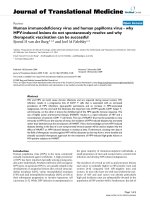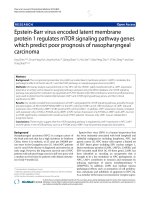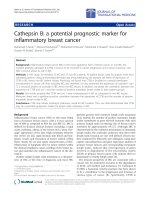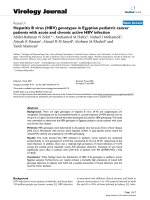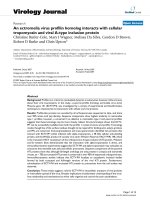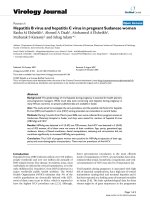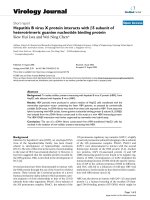báo cáo hóa học:" Hepatitis B virus X protein interacts with β5 subunit of heterotrimeric guanine nucleotide binding protein" docx
Bạn đang xem bản rút gọn của tài liệu. Xem và tải ngay bản đầy đủ của tài liệu tại đây (379.14 KB, 8 trang )
BioMed Central
Page 1 of 8
(page number not for citation purposes)
Virology Journal
Open Access
Short report
Hepatitis B virus X protein interacts with β5 subunit of
heterotrimeric guanine nucleotide binding protein
Siew Hui Lwa and Wei Ning Chen*
Address: School of Chemical and Biomedical Engineering and School of Biological Sciences, College of Engineering, Nanyang Technological
University, Blk 1 Innovation Centre, 16 Nanyang Drive Unit 100 Level 1, Singapore 637722
Email: Siew Hui Lwa - ; Wei Ning Chen* -
* Corresponding author
Abstract
Background: To isolate cellular proteins interacting with hepatitis B virus X protein (HBX), from
HepG2 cells infected with hepatitis B virus (HBV).
Results: HBV particles were produced in culture medium of HepG2 cells transfected with the
mammalian expression vector containing the linear HBV genome, as assessed by commercially
available ELISA assay. A cDNA library was made from these cells exposed to HBV. From yeast two
hybrid screening with HBX as bait, human guanine nucleotide binding protein β subunit 5L (GNβ5)
was isolated from the cDNA library constructed in this study as a new HBX-interacting protein.
The HBX-GNβ5 interaction was further supported by mammalian two hybrid assay.
Conclusion: The use of a cDNA library constructed from HBV-transfected HepG2 cells has
resulted in the isolation of new cellular proteins interacting with HBX.
Background
Infection by hepatitis B virus (HBV), an enveloped DNA
virus of the hepadnaviridae family, has been closely
related to development of hepatocellular carcinoma
(HCC). The role of this virus in the series of events leading
to the onset of HCC has remained elusive [1]. However, it
has been suggested that the smallest protein encoded by
the HBV genome, HBX, is involved in the development of
HCC [2].
Several proteins have been demonstrated to interact with
the HBX protein through the use of the Yeast Two Hybrid
system. These include the C-terminal portion of a novel
human proteasome alpha subunit which possesses a pro-
tein sequence of close relationship to that of the 28 kD
subunits from other organisms; PSMA7, the α-subunit of
the 20S proteasome complex; PSMC1, the subunit of the
19S proteasome regulatory cap complex; XAPC7, a highly
conserved proteasome subunit belonging to the α-subunit
of the 20S proteasome complex. PSMA7, PSMC1 and
XAPC7 were demonstrated to interact with the second
Kunitz-type domain of the HBX protein [3-6]. Another
two proteins, XAP2 (X-associated protein 2) and XIP
(HBX-interacting protein) were found to be negative reg-
ulators of HBX. Overexpression of XAP2 abolished the
transactivating function of HBX while the specific interac-
tion of XIP to the carboxy terminus of HBX in differenti-
ated HCC cells led to a reduction of wild-type HBV viral
replication to levels similar to that observed after transfec-
tion with HBX-minus virus [7,8].
HBX was also shown to interact with XAP-1 (X-associated
protein 1), a human homolog of the monkey UV-dam-
aged DNA-binding protein (UV-DDB) which might be
Published: 31 August 2005
Virology Journal 2005, 2:76 doi:10.1186/1743-422X-2-76
Received: 15 July 2005
Accepted: 31 August 2005
This article is available from: />© 2005 Lwa and Chen; licensee BioMed Central Ltd.
This is an Open Access article distributed under the terms of the Creative Commons Attribution License ( />),
which permits unrestricted use, distribution, and reproduction in any medium, provided the original work is properly cited.
Virology Journal 2005, 2:76 />Page 2 of 8
(page number not for citation purposes)
involved in DNA repair [9]. Besides these, HBX was able
to interact and colocalise with HVDAC3 to the mitochon-
dria, resulting in decreased mitochondrial transmem-
brane potential. HVDAC3 was identified as a new
member of the human voltage-dependent anion channel
(VDAC) family that provides pathways for ATP and
metabolites across the mitochondrial membrane. It con-
stitutes part of the permeability transition pore complex
in the mitochondral membrane which regulates mito-
chondrial transmembrane potential and cytochrome c
release [1].
However, these reported HBX interacting proteins have all
been isolated from normal liver cDNA library (cells that
had not been exposed to HBV), which may reflect physical
but physiologically not meaningful interactions. There is
therefore a need to comprehensively isolate and character-
ize, in a HBV-infected environment, cellular proteins
interacting with the widely studied HBX.
Such an environment has previously been generated in
vitro, firstly by showing that clonal cells derived from
HepG2 transfected with a HBV-containing plasmid could
elicit acute hepatitis in chimpanzees through secretion of
hepatitis B surface antigen (HBsAg) particles and virions
[10], and later by our investigation indicating the produc-
tion of HBV particles in culture medium of HepG2 cells
transfected with a replication competent HBV genome
cloned in a mammalian expression vector [11].
The aim of this study is to isolate cellular proteins interact-
ing with HBX in an HBV-infected environment.
Results and Discussion
Infection of HepG2 Cells by Replicative HBV Genome: an
ELISA Analysis
The culture medium of the HepG2 cells transfected with
infective HBV genome [11] was assayed for the presence
of HBsAg prior to cell harvesting for RNA extraction. In
Table 1, values D1, E1, F1, G1, H1, A2, B2, C2, D2, E2, F2,
G2 and H2 corresponded respectively to the undiluted
medium, its 10×, 10
2
×, 10
3
×, 10
4
×, 10
5
×, 10
6
×, 10
7
×,
10
8
×, 10
9
×, 10
10
×, 10
11
×, 10
12
× serial dilutions measured
at an absorbance of 450 nm. The presence of HBsAg was
indicated in the undiluted medium, its 10 × dilution and
up to 10
4
× dilution. The values of these samples were
respectively, 2.393, 0.464 and down to 0.186. They
exceeded the calculated cut-off of 0.179, thus indicating
the presence of HBsAg. The results of this assay run were
valid as the criteria for the quality control had been met.
The mean A
450
of the negative controls was 0.129, which
did not exceed 0.2. The A
450
of the positive control was
1.494, which was 1.365 higher than the mean A
450
of the
negative controls. The value of the positive control
Table 1: Production of HBV in Transfected HepG2 Cells by ELISA Analysis
Wells Samples Absorbance at 450 nm (A
450
)
A1 Negative Control 1 0.131
A2 Negative Control 2 0.126
A3 Positive Control 1.494
A4 Undiluted growth medium of HBV-transfected HepG2 cells 2.393
A5 10 × diluted growth medium 0.464
A6 10
2
× diluted growth medium 0.164
A7 10
3
× diluted growth medium 0.142
A8 10
4
× diluted growth medium 0.186
Analysis of Insert Size of the cDNA Library from HBV-trans-fected HepG2 CellsFigure 1
Analysis of Insert Size of the cDNA Library from
HBV-transfected HepG2 Cells. Lane 1: 100 bp Marker.
Lanes 2–11: Yeast plasmid DNA extracted from library colo-
nies to check for range of sizes of inserts before use of
library for screening. Lanes 4, 6, 7, 9, 10 and 11 showed
inserts ranging between 300 to 600 bp.
1000bp
800bp
600bp
500bp
11 10 9 8 7 6 5 4 3 2 1
Virology Journal 2005, 2:76 />Page 3 of 8
(page number not for citation purposes)
fulfilled the quality control criteria which requires the
value to be at least 0.8 higher. The cut-off of the assay
reading, 0.179, was derived by adding 0.05 to the mean
A
450
of the negative controls. Based on this cut-off value,
readings that were equivalent to or higher than 0.179
indicated reactive samples. Taken together, our results
indicated the presence of viral infection process in HepG2
cells transfected with the replicative HBV genome.
cDNA Library Construction
The cDNA library that would be used in the yeast-two-
hybrid screening for protein-protein interactions was con-
structed by simultaneous transformation of double-
stranded cDNA and the activation domain vector,
pGADT7-Rec, into yeast strain AH109. After a 4-day incu-
bation period, yeast plasmid DNA was extracted 10 ran-
dom yeast colonies used as template for PCR. Presence of
cDNA inserts of varied sizes ranging between 300 to 600
base pairs were indicated in lanes 4, 6, 7, 9, 10 and 11 as
shown in Figure 1. Library transformants were then har-
vested and pooled.
Yeast Two Hybrid Screening for HBX Interacting Proteins
The total number of colonies that resulted from the yeast
two hybrid screening and the percentage number of colo-
nies that progressively developed a blue colour over a
span of 4 days was tabulated in Table 2. The absence of
blue color for the 10 colonies resulting from the empty
pGBKT7 suggested that 50% of the blue colonies corre-
sponded to HBX-interacting proteins.
Blue colour development was due to the use of the X-α-
Gal assay system as an indication of positive interactions
in the yeast-two-hybrid system. Colonies that resulted
from the screening of the cDNA library and the HBX-
pGBKT7 bait as well as those that resulted from the nega-
tive control reaction which is the interaction between the
empty bait and the cDNA library were observed for their
development of blue colouration on SD/-Ade/-His/-Trp/-
Leu/X-α-Gal agar.
Y187 yeast strain was transformed individually with each
of the 3 control bait constructs empty pGBKT7 vector, full
length HBX in pGBKT7 vector and negative pGBKT7-
Lamin control vector. Colonies that grew on SD/-Trp were
transferred to SD/-Trp/X-α-Gal. Blue colour development
was observed over a period of 5 days. Transformation of
these 3 negative control plasmids into Y187 yeast strain
did not produce yeast colonies on SD/-Ade/-Trp and SD/-
His/-Trp plates after incubation of 5 days. A comparison
of the intensity of blue coloration of positive clones result-
ing from the library screening is shown in Fig 2. In
contrast to these blue colonies, only white color was
observed for the three negative control clones from the
individual transformation of the empty pGBKT7 vector,
full length HBX in pGBKT7 vector and negative pGBKT7-
Lamin control vector.
The negative control experiment as shown in Table 2, in
which an empty bait vector was used in place of the HBX
bait yielded 10 colonies after the screening but none of
these turned blue. Therefore, it can be concluded that the
X-α-Galactosidase assay is a reliable method for determin-
ing positive interactions in the yeast-two-hybrid system.
As shown in Fig. 2, the HBX bait alone did not activate
transcription of the reporter gene that led to blue colour
development. This confirms that the blue colonies which
resulted after screening were indeed due to interactions
between the AD fusion protein and the BD fusion protein
in the two separate yeast strains.
Through the analysis of sequences of 9 positive clones,
only one had a library insert that was in frame with the
activation domain of GAL4 protein on pGADT7-Rec vec-
tor. The insert corresponded to human guanine nucle-
otide binding protein β subunit 5L (GNβ5). Although it
has been well established that HBX interacts with many
molecules of cellular signaling pathway, GNβ5 has hith-
erto not been identified as a HBX-interacting protein. The
use of a cDNA library constructed from HBV-transfected
HepG2 cells would therefore be significant in that it
would enable cellular signaling events occurring after
Table 2: Summary of Yeast Two Hybrid Screening for HBX Interacting Proteins
Transformed Y187 yeast strain Total number of colonies after
interaction with cDNA library
% number of blue colonies
Day
12 3 4
Full length HBX in pGBKT7 1.6 × 10
4
010 20 50
pGBKT7 without HBX 10 0
Virology Journal 2005, 2:76 />Page 4 of 8
(page number not for citation purposes)
HBV infection to be traced via interactions with the HBX
protein which had been implicated in HBV-related hepa-
tocellular carcinoma. This also implies that the use of an
infected library increases the likelihood of identifying new
interacting partners.
Despite the stringency of nutritional selection through the
use of the AH109 yeast strain which contains three report-
ers, namely, ADE2, HIS3 and MEL1, the yeast-two-hybrid
system is only able to reduce the number of false positives.
There still exists an uncertainty of whether interactions are
always true positives. For this reason, the Mammalian-
Two-Hybrid system was used to re-confirm the interac-
tion. This system verifies protein-protein interactions by
transcriptional activation. Similar to the yeast two hybrid
system, the Mammalian-Two-Hybrid Checkmate system
consists of two vectors namely pBIND and pACT. Interac-
tion between two proteins expressed from these two vec-
tors will be assessed by the luciferase activity following the
transient transfection of both vectors into mammalian
cells.
The pBIND-GNβ5 plasmid was transfected together with
the pACT-HBX plasmid and the pG5luc luciferase vector
to test the protein-protein interaction between partial
GNβ5 sequence and full-length HBX in the Mammalian-
Two-Hybrid system. The percentage activity as reflected by
the luciferase reporter was plotted out in the graph shown
in Figure 3. The assay value given by this interaction was
compared against the positive control nteraction between
pACT-MyoD and pBIND-1d and a negative control which
included pBIND-GNβ5 and the empty pACT vector. The
results showed that the luciferase activity triggered by
interaction between the partial GNβ5 and full length HBX
was twenty percent higher than that produced by the neg-
ative control reaction, thus suggesting presence of interac-
tion. However, the luciferase activity of the interaction
was only 63% of that measured for the interaction in the
positive control. Thus, although the experimental value
exceeds that of the negative control, the confirmation of
the interaction between HBX and partial GNβ5 can be fine
tuned by further tests using the same system.
Positive Yeast Colonies with Potential HBX Interacting ProteinsFigure 2
Positive Yeast Colonies with Potential HBX Interacting Proteins. Comparison between control yeast colonies and
positive colonies from the library screening that developed blue colour over a 5-day incubation period at 30°C. A1-5, B1-5,
C1-5, D1-5, E1-5, F1, G6-10, H6-10, I6-10, J6-10, K6-10, L6: colonies that turn blue after α-galactosidase assay screening indi-
cated positive interaction between bait and cDNA library. F2 and L7: control using bait plasmid cloned with HBX transformed
into yeast strain Y187 to test if the bait alone led to transcriptional activation. α-galactosidase assay screening indicate negative
interaction between bait and library. Colonies remained white. F3 and L8: control using negative control plasmid, pGBKT7-
Lamin transformed into yeast strain Y187. α-galactosidase assay screening indicate negative interaction between bait and
library. Colonies remained white. F4 and L9: Control using bait plasmid, pGBKT7 transformed into yeast strain Y187. α-galac-
tosidase assay screening indicate negative interaction between bait and library. Colonies remained white.
A
B
C
D
E
F
G
H
I
J
K
L
123 4 5
6 7 8910
Virology Journal 2005, 2:76 />Page 5 of 8
(page number not for citation purposes)
Possible Role of GN
β
5 in HBX-mediated Cellular Signaling
Pathway
G proteins are heterotrimeric guanine nucleotide binding
proteins that are involved in signal transduction. They are
peripherally associated with the plasma membrane and
function to couple signals to seven transmembrane-span-
ning surface receptors. G proteins consist of α, β and γ
subunits, of which β and γ subunits are tightly associated.
In a typical G protein coupled signaling pathway, the lig-
and-activated receptor catalyzes the exchange of guanine
nucleotides in the α subunit. The GTP-bound α subunit
dissociates from the receptor as well as the βγ subunit and
proceeds to activate its respective effector molecule. The
free βγ subunit also activates a similar or different effector
molecules.
The hydrolysis of the bound-GTP to GDP by intrinsic
GTPase activity of the α subunit leads to a conformational
switch, resulting in the termination of its effector interac-
tion. The resulting α-GDP re-associates with the free βγ
subunit. This is followed by re-entry of the newly formed
heterotrimer into the signaling cycle. To date, 17 α subu-
nits, five β subunits and 12 γ subunits have been identi-
fied [12].
The GNβ5 isolated in our study would be of significance.
Previous reports had suggested that the GNβ5 protein was
essentially soluble. The GNβ5 protein displays sequence
homology to a group of Gβ-like proteins known as the
WD-40 repeat family [13]. It has been proposed that this
repeat enables G protein β subunits to adopt multiple
conformations which could greatly expand the number of
signaling partners.
G proteins and Cancer Development
G proteins have also been implicated in cancer develop-
ment [12]. In the classical paradigm, GPCR-mediated
signal transduction involves the agonist-dependent inter-
action of GPCRs with G proteins at the plasma mem-
brane, and the subsequent generation of soluble second
messengers or ion currents by membrane localized
effectors.
There exist two major mechanisms for transmembrane
signaling in intercellular communication, mediated
respectively by receptor tyrosine kinases and by GPCRs.
Recent evidence shows that the two pathways can con-
verge on the same effectors, for example, Ras and
mitogen-activated protein kinase (MAPK). Both systems
appear to use specific protein-protein interactions for
localization of key signaling intermediates to appropriate
membrane compartments. For receptor tyrosine kinases,
protein-protein interactions are mediated by Src homol-
ogy SH2 and SH3 while for GPCRs, interaction of the βγ
complex of heterotrimeric G proteins [13].
Based on the above, HBX probably associates with GNβ5
at the early cellular stage of HBV infection. From previous
reports that Ras and MAPK constitute the point of
convergence of the tyrosine kinase and the G protein cou-
pled receptor signaling pathways, it is likely that HBX
plays a role in bridging and activating the Src-kinase and
MAPK mediated pathways at the early stage of viral infec-
tion. Further functional studies, including the down-regu-
lation of expression of GNβ5 using siRNA, should shed
new lights on its role in HBV infection.
Methods
Cell Culture and Transfection
HepG2 cells were grown in Dulbecco's Modified Eagle's
Medium (DMEM) (Gibco) supplemented with 10% fetal
calf serum. HepG2 cells cultured in 10 ml of DMEM in a
9 cm × 6 cm flask were transiently transfected by Effectene
(QIAGEN) with 1.5 µg of pcDNA 3.1-HBV DNA when cell
confluence reached 60%. Cells were maintained in a satu-
rated, humidified environment of 5% CO
2
– 95% air at
37°C. After 36 hours of incubation, 1 ml of the cell cul-
ture medium was retained for ELISA analysis.
ELISA Analysis
The HBV DNA level in the culture medium of the trans-
fected HepG2 cells was analysed by ELISA (Murex HBsAg
Version 3, ABBOTT).
Dual-Luciferase Reporter Assay demonstrating the interac-tion between GNβ5 and HBXFigure 3
Dual-Luciferase Reporter Assay demonstrating the
interaction between GNβ5 and HBX. The pBIND-
GNβ5 plasmid was transfected together with the pACT-
HBX plasmid and the pG5luc luciferase vector to test the
protein-protein interaction between partial GNβ5 sequence
and full-length HBX in the Mammalian-Two-Hybrid system.
The percentage activity as reflected by the luciferase
reporter was plotted out in the graph.
100
63
43
0
20
40
60
80
100
120
Posit iv e Cont rol pBind_Gprot ein
clone
Negat ive Cont r ol
(Empt y pACT+
Gpr ot ein )
Sample Identity
%
Activit
y
Virology Journal 2005, 2:76 />Page 6 of 8
(page number not for citation purposes)
Bait Plasmid Construct
The full length HBX gene sequence of 462 base pairs was
amplified by PCR using full length HBV DNA (adw2 sub-
type) as template. Oligonucleotide primers were designed
with NcoI and PstI enzyme restriction sites as follows:
5'-TGCCATGGCAATGGCTGCTAGGCTGTACTGCC-3'
5'-AACTGCAGTTAGGCAGAGGTGAAAAAGTT-3'
The PCR product and the binding domain vector, pGBKT7
of 7.3 kb (MATCHMAKER Two-Hybrid System 3, BD Bio-
sciences) were digested individually with enzymes, NcoI
and PstI. (New England Biolabs) After each enzymatic
digestion, the PCR product and vector were column-puri-
fied. (QIAGEN) 2 µl of the purified PCR product was
ligated to 6 µl of the binding domain vector in a reaction
mixture which included 1 µl of T4 DNA Ligase and 1 µl of
T4 DNA Ligase Buffer (New England Biolabs). Incubation
of the mixture was carried out overnight at 16°C. 5 µl of
the ligation mixture was transformed into 50 µl of DH5α
competent cells (Stratagene). Transformed cells were
plated on 30 µg/ml Kanamycin LB agar plates and incu-
bated at 37°C. Colonies were analysed for presence of cor-
rectly inserted bait DNA using the pair of primers used for
amplifying the corresponding HBX bait DNA in a PCR
reaction. Plasmid DNA from the colony identified to
contain the correct insert was extracted using the Miniprep
Plasmid DNA extraction kit (QIAGEN) and was trans-
formed into yeast strain, Y187 (Clontech Laboratories,
Inc.)
cDNA Library Construction
RNA was isolated from 2 × 10
7
HBV-transfected HepG2
cells in a final elution volume of 50 µl using the RNeasy
Mini Kit (QIAGEN). cDNA was synthesised using the
MATCHMAKER Library Construction and Screening Kit
(Clontech Laboratories, Inc) First strand cDNA synthesis
was carried out using 1 µl of a random CDS III/6 Primer:
5'-ATTCTAGAGGCCGAGGCGGCCGACATG-NNNNNN-
3', 2 µl of RNA and 1 µl of water. The mixture was incu-
bated at 72°C for 2 minutes followed by incubation on
ice for 2 minutes. This was followed by the addition of 2
µl of 5 × First-Strand Buffer, 1 µl of DTT (20 mM), 1 µl of
dNTP mix (10 mM) and 1 µl of Moloney Murine Leuke-
mia Virus Reverse Transcriptase. This was followed by a 10
minute-incubation period at 25°C and a 10 minute-incu-
bation period at 42°C. 1 µl of SMART III Oligonucleotide
(10 µM; 5'AAGCAGTGGTATCAACGCAGAGTGGCCAT-
TATGGCCGGG-3') was addedand the reaction mixtures
were incubated at 42°C for 1 hour. The tube was incu-
bated at 75°C for10 minutes to terminate first-strand syn-
thesis and cooled to room temperature before adding 1 µl
(2 units) of RNaseH. Next, incubation at 37°C was carried
out for 20 minutes. Second strand cDNA was synthesised
by Long Distance-PCR. Sufficient double-stranded cDNA
was prepared for transformation by setting up two 100 µl
reaction mixtures, each composed of the following: 2 µl of
first-strand cDNA, 70 µl of deionised water, 10 µl of 10 ×
Advantage 2 PCR Buffer, 2 µl of 50 × dNTP mix, 2 µl of 5'
PCR Buffer, 2 µl of 3' PCR Buffer, 10 µl of GC-Melt Solu-
tion and 2 µl of 50 × Advantage 2 Polymerase Mix. Ther-
mal cycling was carried out using the following
conditions: 95°C for 30 seconds; 24 cycles of 95°C for 10
seconds, each followed by 68°C for {6 minutes + [5(x)]
seconds} where x increased per cycle from "0, 1, 2, 3, "
to 23; 68°C for 5 minutes. Double-stranded cDNA was
column-purified using CHROMA SPIN + TE - 400 col-
umns (Clontech Laboratories, Inc.).
200 µl of AH 109 yeast competent cells (BD Biosciences)
was transformed with 14 µl of ds cDNA and 6 µl of
pGADT7-Rec. The transformation mixture was distributed
onto 130 100 mm SD/-Leu agar plates. The plates were
incubated at 30°C for 5 days.
Harvesting of Yeast Transformants
1 litre of freezing medium (YPD medium with 25% v/v
glycerol and sterilised at 121°C for 15 minutes) was pre-
pared for the harvest of transformants. 5 ml of freezing
medium was added to each plate and yeast colonies were
scraped off the plates and pooled into a sterile 1 litre con-
ical flask. The mixture was mixed well by swirling the flask
before storing as 1 ml aliquots at -80°C.
Interaction of Yeast Strains
A single yeast colony from the transformation of the bait
plasmid into Y187 yeast strain was innoculated into 50 ml
of SD/-Trp liquid medium and incubated at 30°C with
shaking at 270 rpm. When OD
600
of the culture reached
0.8, it was combined with an 1 ml aliquot of the cDNA
library in a 1-litre conical flask together with 45 ml of
yeast culture medium (2 × YPDA medium with
Kanamycin, 50 µg/ml). The mixture was incubated for 24
hours at 30°C with gentle swirling at 40 rpm.
A drop of the mixture was analysed under phase-contrast
microscope (400×) to check for the presence of zygotes.
Centrifugation of the mixture was carried out at 1000 × g
for 10 minutes and the supernatant was discarded. The
cell pellet was resuspended in 10 ml of 0.5 × YPDA/Kan-
amycin (50 µg/ml). The entire mixture was plated out
onto 100 mm SD/-Ade/-His/-Leu/-Trp agar plates. 100 µl
of the suspension was distributed evenly onto each plate.
The plates were incubated at 30°C for 5 days.
Selection of Yeast Diploids Expressing Interacting Proteins
Only colonies that measured 2 mm or more after 5 days
of incubation at 30°C were selected for further screening.
60 colonies were randomly selected for the first round of
Virology Journal 2005, 2:76 />Page 7 of 8
(page number not for citation purposes)
screening. These were streaked onto SD/-Leu/X-α-Gal agar
plates. The agar plates were incubated at 30°C over a 4-
day incubation period. 52 colonies that turned blue at the
end of the 4-day incubation period on the SD/-Leu/X-α-
Gal agar plates were individually innoculated into 10 ml
of SD/-Leu medium and 5 ml of SD/-Ade/-His/-Leu/-Trp
medium. The liquid cultures were incubated with shaking
at 30°C, 280 rpm. After 48 hours, glycerol stocks of these
cultures were prepared by adding 1.4 ml of each culture to
0.3 ml of glycerol and 0.3 ml of the respective medium.
The stocks were stored at -80°C. The SD/-Leu cultures
were centrifuged at 5500 rpm, 4°C, for 10 minutes. Yeast
plasmid extraction was carried out to determine library
insert sizes. 2 µl of extracted plasmid was used as template
for PCR. 52 samples corresponding to bands with sizes of
approximately 500 basepairs or more were purified using
PCR purification columns (QIAGEN) and sequenced.
These 52 colonies were also streaked onto SD/-Trp/X-α-
Gal agar plates in a grid-like pattern. The following plas-
mids, the pGBKT7 vector, pGBKT7 cloned with full-length
HBX and the pGBKT7-Lamin negative control vector (BD
Biosciences) were transformed into Y187. The resulting
colonies were used as controls. The agar plates were incu-
bated at 30°C and the rate at which the colonies turned
blue over a 4-day incubation period was noted.
Confirmation of Interaction by Mammalian CheckMate
System
The partial human guanine nucleotide binding protein β
subunit 5L (GNβ5) insert was amplified for cloning in-
frame with the GAL 4 containing binding domain vector,
pBIND (CheckMate System, Promega) for use in the
Mammalian-two-hybrid system. The 5' and 3' primers
were designed with BamHI and EcoRV digestion sites
respectively as follows: 5'-GAGGATCCTCAAAGATAA-
GAGGAGGATCGT-3' and 5'-GAGATATCTCG-
GGGGCCAGGTCCAAGCAGA-3'
HBV DNA (adw2 subtype) was used as template for PCR
to amplify the full length HBX sequence of 462 base pairs
using the following 5' and 3' primers which were designed
with SalI and EcoRV digestion sites respectively:
5'-TGGTCGACCAATGGCTGCTAGGCTGTACTGC-3'
5'-AAGATATCTTTTAGGCAGAGGTGAAAAAGTT-3'
The resulting PCR product was purified and cloned into
the Herpes Simplex Virus VP16 activation domain vector,
pACT, of the Mammalian-two-hybrid system (CheckMate
System, Promega).
Transfection of HepG2 Cells
Transfection of HepG2 cells was carried out using Effect-
ene reagent (QIAGEN) when cells reached 35% conflu-
ence. Duplicated reactions were carried out in two 6-well
plates. For each of the positive control, negative control
and experimental wells, 1.2 ng of combined DNA com-
posing of 3 different plasmids in a 1:1:1 ratio was used.
The positive control reaction consisted of 0.4 ng of each of
the following vectors, pG5luc, pBIND-1d and pACT-
MyoD. The negative control reaction consisted of 0.4 ng
of each of the following vectors, pG5luc, empty pACT vec-
tor and the GNβ5-pBIND vector. The actual experimental
reaction to confirm the interaction consisted of 0.4 ng of
each of the following vectors, pG5luc GNβ5-pBIND vector
and the HBX-pACT vector. Cells were incubated in a satu-
rated, humidified environment of 5% CO
2
– 95% air at
37°C. After 2 hours of incubation, the growth medium
was aspirated and the cells were washed twice using 2 ml
of PBS per wash. 2 ml of fresh medium was added to each
well and the plates were incubated in 5% CO
2
and 95% air
at 37°C for 36 hours.
Harvesting and Lysis of Transfected cells
The transfected cells were trypsinised and the cell suspen-
sion of each well was collected and centrifuged at 1500
rpm at 4°C for 3 minutes. The supernatant was removed
and each cell pellet was resuspended in 4 ml of PBS. Cen-
trifugation was then carried out at 1500 rpm at 4°C for 3
minutes. The supernatant was discarded and 250 µl of 1 ×
Passive Lysis Buffer (Promega) was used to lyse each cell
pellet.
Dual-Luciferase Reporter Assay
20 µl of each test sample was mixed with 100 µl of Luci-
ferase Assay Reagent II (Promega) in a luminometer tube.
The luminometer (Sirius Tube Luminometer, Berthold
Detection Systems) was programmed to provide a 2-sec-
ond pre-read delay, followed by a 10-second measure-
ment period for each reporter assay. Upon recording the
first reading, 100 µl of 1 × Stop & Glo Reagent (Promega)
was promptly added to the reaction mix. After mixing, the
second reading was recorded.
Competing interests
The author(s) declare that they have no competing
interests.
Authors' contributions
SH Lwa was a recipient of a graduate research scholarship
from Nanyang Technological University, and conducted
experiments under the direction of Dr. Chen. Dr. Chen
initiated the research, writing of the draft manuscript with
subsequent editing and revisions by both authors.
Acknowledgements
This work was supported by grant 03/1/22/18/229 (WN Chen) from the
Biomedical Research Council, Agency for Science, Technology and
Research, Singapore.
Publish with BioMed Central and every
scientist can read your work free of charge
"BioMed Central will be the most significant development for
disseminating the results of biomedical research in our lifetime."
Sir Paul Nurse, Cancer Research UK
Your research papers will be:
available free of charge to the entire biomedical community
peer reviewed and published immediately upon acceptance
cited in PubMed and archived on PubMed Central
yours — you keep the copyright
Submit your manuscript here:
/>BioMedcentral
Virology Journal 2005, 2:76 />Page 8 of 8
(page number not for citation purposes)
References
1. Rahmani Z, Huh KW, Lasher R, Lasher R, Siddiqui A: HBV X pro-
tein colocalizes to mitochondria with a human voltage-
dependent anion channel, HVDAC3, and alters its trans-
membrane potential. J Virol 2000, 74:2840-2846.
2. Nijhara R, Jana SS, Goswami SK, Rana A, Majumdar SS, Kumar V,
Sarkar DP: Sustained activation of mitogen-activated protein
kinases and activator protein 1 by the hepatitis B virus X
protein in mouse hepatocytes in vivo. J Virol 2001,
75:10348-10358.
3. Fischer M, Runkel L, Schaller H: HBx protein of hepatitis B virus
interacts with the C-terminal portion of a novel human pro-
teasome alpha-subunit. Virus Genes 1995, 10:99-102.
4. Hu Z, Zhang Z, Doo E, Coux O, Goldberg AL, Liang TJ: Hepatitis B
virus X protein is both a substrate and potential inhibitor of
the proteasome complex. J Virol 1999, 73:7231-7240.
5. Huang J, Kwong J, Sun EC, Liang TJ: Proteasome complex as a
potential cellular target of HBX protein. J Virol 1996,
70:5582-5591.
6. Zhang Z, Torii N, Furusaka A, Malayaman N, Hu Z, Liang TJ: Struc-
tural and functional characterization of interaction between
hepatitis B virus X protein and the proteasome complex. J
Biol Chem 2000, 275:15157-15165.
7. Kuzhandaivelu N, Cong YS, Inouye C, Yang WM, Seto E: XAP2, a
novel hepatitis B virus X-associated protein that inhibits X
transactivation. Nucleic Acids Res 1996, 24:4741-4750.
8. Melegari M, Scaglioni PP, Wands JR: Cloning and characterization
of a novel hepatitis B virus x binding protein that inhibits
viral replication. J Virol 1998, 72:1737-1743.
9. Lee TH, Elledge SJ, Butel JS: Hepatitis B virus X protein interacts
with a probable cellular DNA repair protein. J Virol 1995,
69:1107-1114.
10. Sells MA, Zelent AZ, Shvartsman M, Acs G: Replicative intermedi-
ate of hepatitis B virus in HepG2 cells that produce infec-
tious virions. J Virol 1988, 62:2836-2844.
11. Chen WN, Oon CJ: Changes in antigenicity of a hepatitis B
virus mutant stemming from lamivudine therapy. Antimicrob
Agents Chemother 2000, 44:1765.
12. Radhikal V, Dhanasekaran N: Transforming G proteins. Oncogene
2001, 20:1607-1614.
13. Inglese J, Koch WJ, Touhara K, Lefkowitz R: G-βγ interactions with
PH domains and Ras-MAPK signaling pathways. TIBS 1995,
20:151-155.


